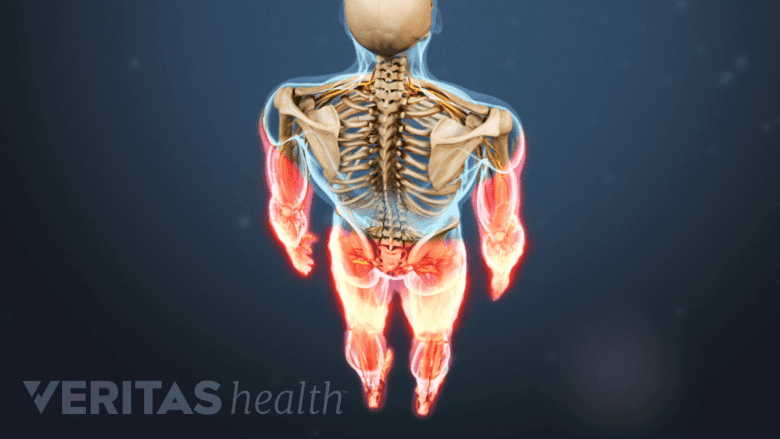Neuropathic pain symptoms are often unpredictable, and vary significantly from person to person. Pain may be triggered by a specific stimulus, or occur on its own. In the case of a sudden impact, the area surrounding the site of the trauma may be affected in addition to the immediate area.
Some people have constant pain, while others may experience pain that occurs on and off.
In This Article:
- All About Neuropathy And Chronic Back Pain
- Understanding Neuropathy Symptoms
- Anatomy Of Nerve Pain
- Types of Back Pain
Neuropathy May Limit Daily Functioning

Neuropathic pain often radiates along nerve pathways into the extremities.
Neuropathic pain often makes movement painful, leading an individual to limit mobility. Being sedentary can cause muscles to weaken, further restricting physical functioning. Many people with neuropathy are unable to work.
Back pain or other pain caused by neuropathy is typically described in the following terms:
- Severe, sharp, electric shock-like, shooting, lightning-like, or stabbing
- Deep, burning, or cold
- Persistent numbness, tingling, or weakness
- Pain that travels along the nerve path into the arms, hands, legs, or feet
See Leg Pain and Numbness: What Might These Symptoms Mean?
Skin in the painful area may be discolored, appearing more pink or red than usual. In some cases, the skin may have a blue or mottled appearance. Changes in color are usually related to changes in blood flow. Some individuals also experience swelling.
Many people with neuropathic pain also experience sleep difficulties and depression, both of which can increase the perception of pain.1Choy EH. The role of sleep in pain and fibromyalgia. Nat Rev Rheumatol. 2015;11(9):513-20. AND Woo AK. Depression and Anxiety in Pain. Reviews in Pain. 2010;4(1):8-12. doi:10.1177/204946371000400103. A multifaceted pain management approach may be beneficial to address all aspects of the person’s health.
Unusual Sensations in Neuropathy
People with neuropathic pain may experience sensations in unusual ways, such as:
- Hypersensitivity to light touch that would be barely noticeable to others, is known as allodynia. The feeling of clothing against the skin, for instance, could trigger a reaction.
- Hyperalgesia is an extreme sensitivity to something slightly painful to others.
- An unusually low sensation to hot or cold is called hypoesthesia.
- An electric-shock or pins-and-needles feeling when there is no contact, a known as paresthesia.
Sensory tests may be conducted to see how the individual responds to different types of physical contact.
Treatment for Neuropathic Pain
Decompression surgery, such as laminectomy, relieves leg pain by removing the pressure on the nerve.
Electromyography and nerve conduction studies, blood tests, and diagnostic tests such as magnetic resonance imaging (MRI) may be used to determine the cause—or rule out a potential cause. Test results can be helpful in finding the most effective therapy.
See Introduction to Diagnostic Studies for Back and Neck Pain
Some cases are more straightforward than others. If a nerve is compressed by a herniated disc, for instance, decompression surgery can relieve the pain by removing the pressure on the nerve.2Macaré van maurik JF, Van hal M, Van eijk RP, Kon M, Peters EJ. Value of surgical decompression of compressed nerves in the lower extremity in patients with painful diabetic neuropathy: a randomized controlled trial. Plast Reconstr Surg. 2014;134(2):325-32.
If no underlying cause of the pain is found, treatment typically emphasizes pain relief. There is no single medication that eliminates the symptoms of neuropathy, but a combination of medications and treatments may be helpful Care from an interdisciplinary pain management team may be advised for individuals with neuropathic pain.
- 1 Choy EH. The role of sleep in pain and fibromyalgia. Nat Rev Rheumatol. 2015;11(9):513-20. AND Woo AK. Depression and Anxiety in Pain. Reviews in Pain. 2010;4(1):8-12. doi:10.1177/204946371000400103.
- 2 Macaré van maurik JF, Van hal M, Van eijk RP, Kon M, Peters EJ. Value of surgical decompression of compressed nerves in the lower extremity in patients with painful diabetic neuropathy: a randomized controlled trial. Plast Reconstr Surg. 2014;134(2):325-32.

